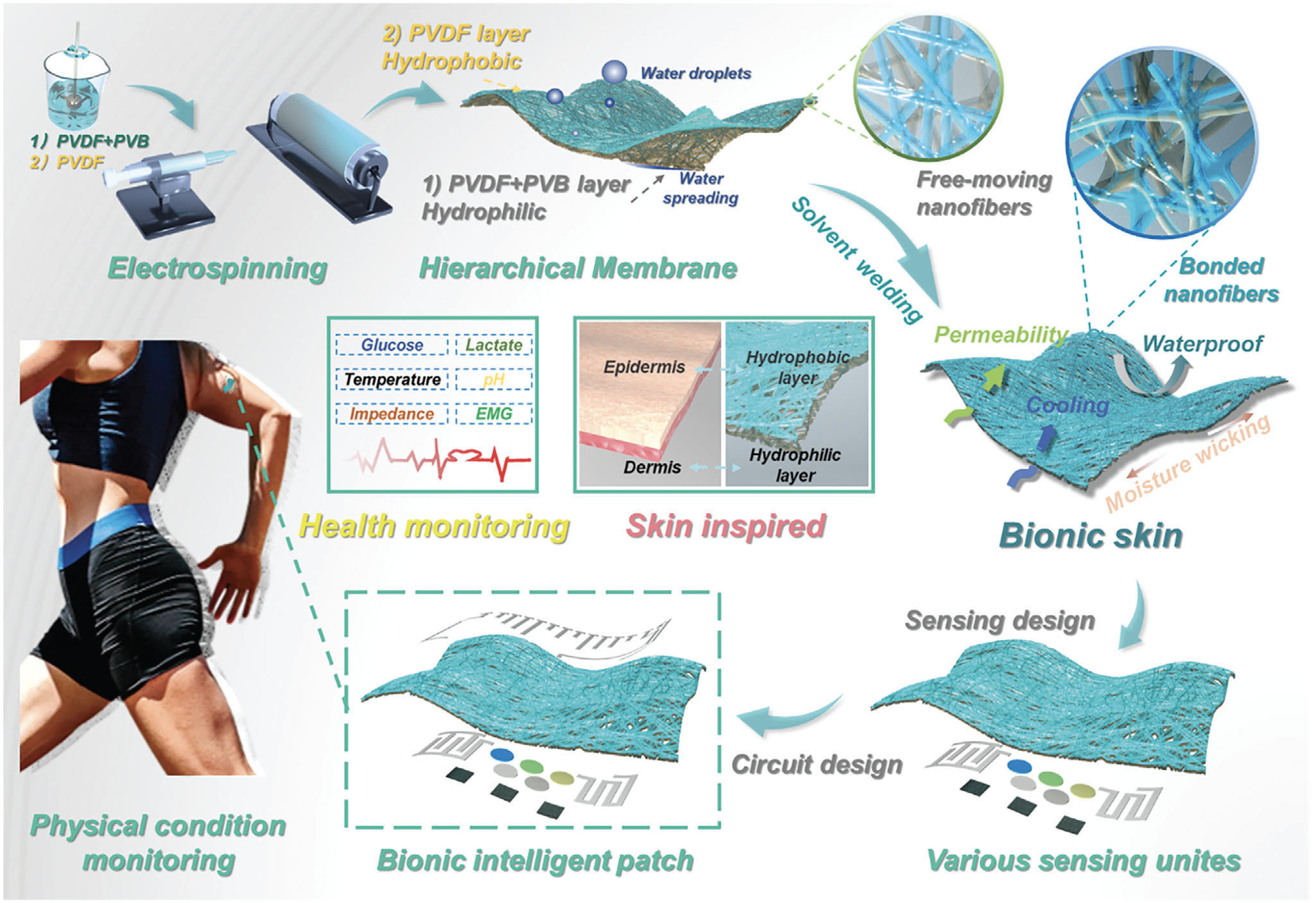| Oct 05, 2023 | |
Improving health monitoring with breathable bionic skin |
|
| (Nanowerk Spotlight) The rapidly aging global population is facing a growing public health crisis, with chronic diseases afflicting over 60% of adults in the U.S. alone. Conventional medical detection relies on invasive blood draws and complex equipment, making frequent monitoring cumbersome. Wearable biosensors offer a promising solution, allowing continuous health tracking through the skin. However, most wearables lack the breathability and moisture control of real skin. | |
| Now, researchers from City University of Hong Kong have developed an intelligent “bionic skin” patch that closely mimics the performance and feel of human skin while continuously monitoring biomarkers. Their breathable sensor array, described in Advanced Materials ("A Bionic Skin for Health Management: Excellent Breathability, In Situ Sensing, and Big Data Analysis"), could promote personalized health management. | |
| Human sweat contains valuable health indicators. Glucose levels help diagnose and monitor diabetes. Lactic acid signifies muscle fatigue and ischemia risk. Sodium and pH correlate to kidney disease, epilepsy and sepsis. Skin temperature and impedance track inflammation, circulation and skin infections. Electromyography (EMG) reveals muscle and nerve conditions like ALS. However, these biomarkers are impractical to monitor via repeated blood draws. | |
| Previously, most flexible sensors sacrificed comfort for functionality. The new bionic skin leverages electrospinning to create a hierarchical fiber structure resembling skin, with an inner hydrophilic layer for sweat wicking and an outer hydrophobic layer for waterproofing circuitry. This biomimetic design provides air permeability, moisture control and durable sensors encased in a skin-like membrane. | |
 |
|
| The schematic diagram of bionic intelligent skin with air permeability, moisture permeability, waterproofness, multifunctional sensing property, and big data analysis for different physical conditions. (Reprinted with permission by Wiley-VCH Verlag) (click on image to enlarge) | |
| The researchers optimized the nanoscale morphology for maximal breathability by tuning electrospinning parameters like polymer concentration and voltage. The resulting fibers measure just 160-190 nm in diameter, with 300 nm pores evenly distributed throughout the bionic skin. For mechanical strength, they utilized a solvent-welding process to fuse crossing nanofibers into robust physical junctions. Overall, the bionic skin exhibits air permeability similar to textiles, a tensile strength of 20.7 MPa and over 100% elongation before breaking – remarkably close to human skin. | |
| Built into the inner hydrophilic layer, the team integrated a toolbox of chemical sensors to monitor glucose, lactic acid and pH in sweat, important indicators of metabolism and muscle fatigue. The bionic skin’s moisture wicking capability allows efficient analyte collection from tiny sweat volumes. Skin temperature and impedance sensors track additional vital signs, while an electromyography (EMG) electrode monitors muscle and nerve signals. | |
| Liquid metal traces patterned on the outer hydrophobic surface collect and transmit sensor data to external electronics without sweat interference. Researchers showed the printed circuits maintain high conductivity even when stretched and folded. In comprehensive trials, the bionic skin tracked individuals’ glucose, lactate and pH levels, along with skin temperature and impedance, during exercise and sports. Analyzing a multitude of biomarkers provides deeper insights into health and performance. | |
| Compared to gel electrodes, the bionic skin offered superior comfort and breathability during long-term wear trials. Its biomimetic structure also enables passive radiative cooling, reducing skin temperature up to 1.2°C versus gel patches. Analyzing biocompatibility, cell studies confirmed the bionic skin has no toxicity issues for real-world use. | |
| Overall, the researchers achieved a multifunctional printable sensor array matching both the performance and comfort of natural skin. The breathable bionic skin could enable continuous health tracking during exercise and daily activities. By gathering long-term biomarkers not feasible with infrequent blood tests, it has potential to transform personalized health management and medical diagnostics. The bioinspired design principles could also guide future advances in flexible, wearable electronics. | |
 By
Michael
Berger
– Michael is author of three books by the Royal Society of Chemistry:
Nano-Society: Pushing the Boundaries of Technology,
Nanotechnology: The Future is Tiny, and
Nanoengineering: The Skills and Tools Making Technology Invisible
Copyright ©
Nanowerk LLC
By
Michael
Berger
– Michael is author of three books by the Royal Society of Chemistry:
Nano-Society: Pushing the Boundaries of Technology,
Nanotechnology: The Future is Tiny, and
Nanoengineering: The Skills and Tools Making Technology Invisible
Copyright ©
Nanowerk LLC
|
|
|
Become a Spotlight guest author! Join our large and growing group of guest contributors. Have you just published a scientific paper or have other exciting developments to share with the nanotechnology community? Here is how to publish on nanowerk.com. |
|
